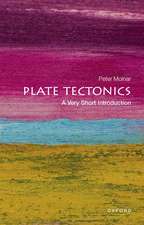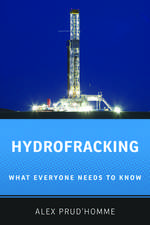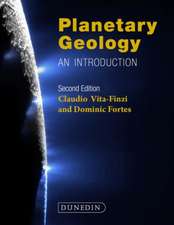Geology of Western Gondwana (2000 - 500 Ma): Pan-African-Brasiliano Aggregation of South America and Africa (translated by A.V.Carozzi, Univ.of Illinois, USA)
Autor Roland Trompetteen Limba Engleză Hardback – 1994
Preț: 1231.21 lei
Preț vechi: 1501.47 lei
-18% Nou
Puncte Express: 1847
Preț estimativ în valută:
235.62€ • 245.08$ • 194.52£
235.62€ • 245.08$ • 194.52£
Carte tipărită la comandă
Livrare economică 12-26 aprilie
Preluare comenzi: 021 569.72.76
Specificații
ISBN-13: 9789054101659
ISBN-10: 9054101652
Pagini: 362
Dimensiuni: 174 x 246 x 21 mm
Greutate: 0.83 kg
Ediția:1
Editura: CRC Press
Colecția CRC Press
ISBN-10: 9054101652
Pagini: 362
Dimensiuni: 174 x 246 x 21 mm
Greutate: 0.83 kg
Ediția:1
Editura: CRC Press
Colecția CRC Press
Cuprins
PREFACE -- ACKNOWLEDGEMENTS -- 1 INTRODUCTION -- 1.1 Subject matter and organization -- 1.2 Investigated area and time span -- 1.3 Major structural units or geological provinces -- 1.3.1 The Amazonian craton and adjacent fold belts -- 1.3.2 The West-Afdcan craton and adjacent fold belts -- 1.3.3 The Congo or Zaire-Sao Frangisco craton and adjacent fold belts -- 1.3.4 The Kalahari craton and adjacent fold belts -- 1.3.5 The Rio de la Plata craton and adjacent fold belts -- 1.3.6 The particular case of Northeast Brazil and its African Extension -- 1.4 Geodynamic evolution of Western Gondwana -- 1.5 Location of Pan-African-Brasiliano sutures -- PART 1: THE PAN-AFRICAN-BRASILIANO CRATONS -- 2 THE BASEMENT OR INFRASTRUCTURE OF THE PAN-AFRICAN-BRASILIANO CRATONS -- 2.1 The West-African craton -- 2.1.1 The Reguibat block -- 2.1.2 The Man-Leo block and its extension in Brazil -- 2.1.3 Conclusions -- 2.2 The Amazonian or Amazon craton -- 2.2.1 The Guyana or Rio Branco block -- 2.2.2 The Guapore or Central Brazil block -- 2.2.3 Conclusions -- 2.3 The Congo (Zaire)-Sao Francisco craton -- 2.3.1 The Sao Francisco massif or craton -- 2.3.2 The Congo or Zaire block or craton -- 2.4 The Rio de la Plata craton -- 2.5 The Kalahari or South-African craton -- 3 LATE EARLY-MIDDLE PROTEROZOIC COVER AND METASEDIMENTARY SEQUENCES 3.1 The West-African craton -- 3.1.1 The Adrar of Mauritania -- 3.1.2 TheGourma -- 3.1.3 The Volta Basin -- 3.1.4 Conclusions to the study of the Pan-African cover rocks of the West-African craton -- 3.2 The Amazonian or Amazon craton -- 3.2.1 The cover rocks of the Amazonian craton north of the 13° south parallel -- 3.2.2 The southern extension of the Guapore block south of the 13° south parallel -- 3.2.3 Conclusions to the study of the late Early-Middle-Late Proterozoic sequences -- 3.3 The Congo (Zaire)-Sao Francisco craton -- 3.3.1 The Sao Francisco block or craton (Brazil) -- 3.3.2 The Congo or Zaire block or craton -- 3.3.3 Conclusions to the study of the Late-Early-Middle-Proterozoic sequences -- 3.4 The Rio de la Plata craton -- 3.5 The Western portion ofthe Kalahari craton -- PART 2: THE PAN-AFRICAN-BRASILIANO FOLD BELTS -- 4 DEFINITION, PRESENTATION -- 5 THE TRANS-S AH ARAN MEGA-OROGEN -- 5.1 Recognition of a suture -- 5.2 The slightly tectonized passive margin of the West-African craton -- 5.3 The highly tectonized passive margin and the active margin -- 5.3.1 The materials -- 5.3.2 Geodynamic evolution: Granitization and molassic deposits -- 5.4 Conclusions -- 5.5 Extension of the Trans-Saharan mega-fold belt into Brazil -- 6 THEWEST-CONGO-ARAgUAI AND RIBEIRAFOLD BELTS -- 6.1 The West-Congo-Araguai fold belt -- 6.1.1 The metasediments ofthe external units -- 6.1.2 The materials of the granitized and highly metamorphosed central zone -- 6.1.3 The structure of the Araguai-West-Congo fold belt and conclusions -- 6.2 The Ribeira-Mantiqueira fold belt -- 6.2.1 The materials -- 6.2.2 The structure -- 6.2.3 Conclusion: The geodynamic evolution -- 7 THE BRASILIA FOLD BELT: THE COLLISION BETWEEN THE CONGO-S AO FRANCISCO ANDAMAZONPLATES -- 7.1 The materials -- 7.1.1 The basement -- 7.1.2 The late Early-Middle Proterozoic metasediments -- 7.1.3 The late Middle and Late Proterozoic metasediments -- 7.2 Structure and geodynamic evolution -- 7.3 Conclusions -- 8 THE DOM FELICIANO, KAOKO (ATLANTIC DAM ARA), GARIEP AND MALMESBURY FOLDBELTS -- 8.1 TheSouthAmericanDomFelicianofoldbelt -- 8.1.1 The northern segment or Tyucas fold belt -- 8.1.2 The median segment in Rio Grande do Sul -- 8.1.3 The southern segment in Uruguay -- 8.2 The Kaoko or Atlantic branch of the Damara fold belt -- 8.3 The Gariep fold belt -- 8.4 The Malmesbury fold belt -- 8.5 Conclusions on South-Atlantic Pan-African-Brasiliano fold belts -- 9 THE DAMARA (S .L.) FOLD BELTS: THE INTERNAL AND THE ATLANTIC OR KAOKO BRANCHES -- 9.1 The filling of the internal Damara ‘geosyncline’ -- 9.2 Structure, metamorphism, and granitoids -- 9.3 Dynamic evolution: proposed models -- 9.4 The Kaokoveld fold belt or Atlantic branch of the Damara -- 10 THE E-W OUBANGUIDE-SERGIPE MEGA-OROGEN -- 10.1 The Sergipane(s.L) or Sergipe fold belt -- 10.1.1 The general structure -- 10.1.2 Thematerials -- 10.1.3 The geodynamic evolution -- 10.2 The Oubanguide fold belt -- 10.2.1 The general structure -- 10.2.2 Thematerials -- 10.2.3 The geodynamic evolution -- 10.3 Conclusions -- 11 THE FESTOON OF WEST-AFRICAN TRANS SOUTH-AMERICAN FOLD BELTS -- 11.1 The Pan-African Bassaride and Rokelide fold belts -- 11.2 The Araguaia and Paraguay fold belts -- 11.2.1 The Paraguay fold belt -- 11.2.2 The Araguaia fold belt -- 11.2.3 Conclusions: Geodynamic models -- 11.3 The Sierras Pampeanas fold belt in Argentina -- 11.4 Conclusions -- PART 3: AMOSAIC OF PAN-AFRICAN-BRASILIANO MEMI-CRATONS AND MINI-FOLD BELTS: NORTHEAST BRAZIL AND THE CENTRAL-WESTERN PORTION OF AFRICA -- 12 NORTHEAST BRAZIL AND ITS AFRICAN CONTINUATION: STRUCTURE AND INVOLVED MATERIALS -- 12.1 The southern lateral or frontal zone -- 12.2 The central fan -- 12.2.1 The Serido fold belt, NE Brazil: A type Brasiliano metasedimentaiy sequence? -- 12.2.2 The Ceara Group, NE Brazil -- 12.2.3 The‘Schist Belts’of Western Nigeria -- 12.2.4 The central and eastern Hoggar -- 12.3 The lateral western zone -- 12.4 The Pemambuco-Patos shear band and its African extension -- 12.5 The molassic deposits -- 12.6 The granitoids -- 12.7 Conclusions -- PART 4: C ONCLUSIONS AND DISCUSSIONS -- 13 THE AMALGAMATION OF WESTERN GONDWANA(~ 600 Ma): ITS SUTURING (~ 500 Ma) WTTHEASTERNGONDWANA -- 13.1 Pre-Pan-African Brasiliano geological evolution -- 13.1.1 The example of the West-Africa, Amazon and Rio de la Plata mega-craton -- 13.1.2 The example of the Congo (Za5fre)-Sao Francisco craton -- 13.1.3 The infrastructure of some Pan-African-Brasiliano fold belts -- 13.1.4 Diversity of geodynamic evolution in Western Gondwana -- 13.2 The Pan-African-Brasiliano sedimentation -- 13.2.1 Variable ages of metasedimentaiy fills: Comparison with cratonic cover sequences -- 13.2.2 Rifting, glaciation, and ferruginous sedimentation during the late Proterozoic -- 13.3 Hie Pan-African-Brasiliano orogeny -- 13.3.1 The Trans-Saharan mega-fold belt -- 13.3.2 The set of fold belts fringing the South- Adantic Ocean -- 13.3.3 The Oubanguide-Seigipe mega-fold belt -- 13.3.4 The NE-Brazil-Central west-Africa Plate -- 13.3.5 The festoon of the West-Afncan Trans South-American fold belts -- 13.3.6 The amalgamation of West Gondwana and its collision with East Gondwana -- 13.4 Tectonic inheritance in the opening of the South Atlantic -- REFERENCES -- INDEX.
Notă biografică
Laboratoire Geosciencesde I’environment, Universited’aix-Marseille, Marseille, France.
Descriere
In considering the geology of Western Gondwana, this text covers: the Pan-African-Brasiliano cratons; the Pan-African-Brasiliano fold belts; and amosaic of Pan-African-Brasiliano mini-cratons and mino-fold belts: Northeast Brazil and the Central-W...











